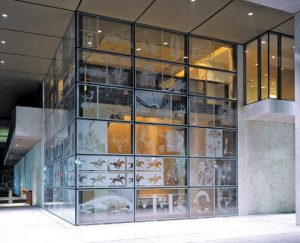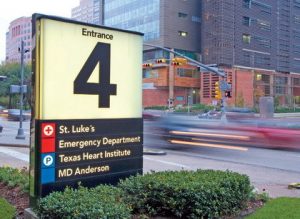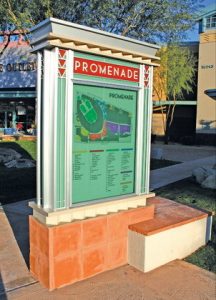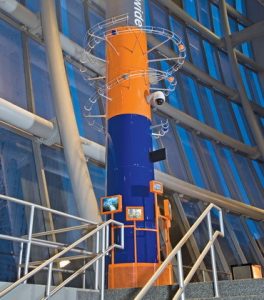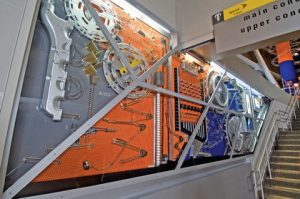Design
Design Trends
Environmental-graphic designers offer their signage perspectives
Published
16 years agoon
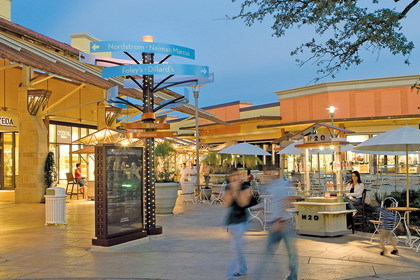
Sign-industry professionals understand that designing signage graphics is a decidedly custom proposition. A hospital requires brightly colored environmental graphics that direct harried visitors efficiently, whereas an upscale hotel or spa may impart subtle signage with ornate, elegant materials and letterstyles that resonate with the affluent. In a similar vein, quick-service restaurants must incorporate more utilitarian signage than a four-star counterpart.
However, successful, environmental-graphic design for today’s extremely demanding, impatient clientele requires an even more nuanced approach. Common questions may include:
• Does the client’s on-premise signage need to attract the attention of pedestrians, motorists or both?
• Does the municipality, property-management group or other overseeing jurisdiction stipulate strict codes that dictate a sign’s scope, color or content?
• Does the client require or prefer to use Leadership in Energy and Environmental Design (LEED)-approved methods or material.
AdvertisementManaging the workflow between designers and fabricators – as well as architects, general contractors, end users and other parties involved can perennially impede design-build relationships. However, some environmental-graphic-design (EGD) professionals and sign fabricators have significantly bridged the gap between conception and completion.
Here are some insights from several EGD providers, as well as the president of a sign company who’s active in the Society for Environmental Graphic Design (SEGD), the industry’s standard-bearing design organization, about trends and methodologies that may help optimize your next project, and some contemplation about design’s role in developing a successful signage solution.
Steven Stamper, fd2s
Steven Stamper, principal of Austin, TX-based fd2s, currently serves as SEGD president. He began his EGD career with Intergraphic Design, a Houston-based design studio, during the economic boom of the mid-1980s. A summer and weekend job working for a signshop during his collegiate career helped him appreciate the fabricator’s perspective.
“When I handlettered signs, I learned to appreciate the intricacies of different typestyles,” Stamper recalled. “This helped steer me towards a graphic-design career.”
AdvertisementAfter having worked for a Houston-based design firm, he joined the then-fledgling EGD field. According to Stamper, although difficult to fathom today, industry veterans can recall when wayfinding and environmental graphics rated little, if any, consideration during site planning and development.
“During the 1980s, the real-estate market boomed, and the competition motivated property owners and managers to find ways to visually appeal to potential customers,” Stamper said.
“So, wayfinding and other graphic elements have since played an increasing role with the promotion of commercial properties.”
The passage of the Americans with Disabilities Act (ADA) in 1990 also helped craft EGD’s direction, according to Stamper: “Before then, metals and glass were the standard materials in any building’s graphic-identification program. With the advent of ADA, tactile signs were required, which gave rise to etched-zinc, photopolymer and other media that enabled economical production of compliant, 3-D, Braille-laden signage. Also, improvements with digital-printing materials and processes have made them increasingly durable and versatile, which has bolstered EGD applications.”
Hence, as the Internet and wireless technologies have made communication infinitely more portable, signage must more closely correlate with an institution’s or facility’s intended brand identity.
He said, “First, it’s important to identify what tools an institution currently uses to convey information to the public. Then, a designer should analyze their effectiveness and accuracy. More often than not, there are issues with inconsistencies and usability. It’s all about the user; if they experience any of these problems, they chip away at user confidence and harm the brand experience. The number of signs isn’t usually the issue; rather, it’s their accuracy, logic and strategy to create wayfinding that integrates with web-based, print or face-to-face communication.”
AdvertisementThe firm’s numerous international projects have included high-end, retail centers in the United Arab Emirates and Portugal. Stamper said these projects and the attending business practices didn’t diverge heavily from domestic EGD, although (obviously) they entailed a much more demanding travel schedule and greater sensitivity to personal relationships.
Of course, no singular EGD solution that transcends all environments. According to Stamper, the emphasis on signage can depend on whether a building offers intuitive design and clearly defined public spaces.
“When I began my career, many architects for whom I worked considered signage unimportant,” he said. “That attitude has changed with most firms, but certain spaces are more dependent upon signage, and environments should be carefully analyzed to deliver appropriate graphic solutions.”
Fd2s works with several regional and national sign fabricators, but doesn’t maintain a short list of standing partners. Moreover, the firm seldom hires its vendors – the owner or general contractor usually assumes that task. However, he seeks several characteristics from a fabricator.
“First and foremost, there must be a commitment to product quality and project management,” Stamper said. “There also has to be open communication. Most of these types of projects function as a triangle between us, the fabricator and the owner. Clear roles and responsibilities are key to successful projects.”
He noted how improvements in project-management software and the elimination of manual-file exchange have enhanced efficiency. Stamper especially likes 37 Signals’ (Chicago) Basecamp program because of its customization capabilities and easily accessible time-tracking, extranet, file-sharing and related functions.
In the future, he foresees dynamic messaging as a future EGD trend as real-time, interactive information becomes an increasingly vital environmental-graphics component.
Wayne Hunt
Wayne Hunt, principal of Pasadena, CA-based Hunt & Assoc., founded his firm in 1977. In its embryonic days, the firm primarily handled marketing-oriented work, but gradually shifted its focus towards creating graphics for “the built environment.” In his estimation, EGD as a discipline has only existed for approximately 40 years, and its priority has grown exponentially.
“Within the last 10 to 15 years, we haven’t needed to beg to be let in on a project before the last minute,” Hunt said. “Increasingly, our contributions are given the same importance as the landscape architect’s. Studies have shown that effective signage can increase traffic or sales volume by a few percentage points, which clients often realize.”
Because the company works nationally – and, occasionally, internationally, such as exhibit graphics Hunt Design recently designed for a Vienna museum – the company has developed relationships with fabricators nationwide.
Hunt said, “There’s so much diversity within sign companies, it’s hard to say there’s a one-size-fits-all provider. Some shops that do good work are expansive operations that employ 50 workers; others are a just a guy and his bandsaw and vinyl cutter. A lot depends on the project’s scope and production schedule. Also, I’m looking for a provider who can help us do our job better, which entails proactive communication and an understanding of the language of design.”
Like Stamper, Hunt sees a substantial trend towards dynamic-message, LED displays for designed environments, but he thinks products currently on the market aren’t sufficient, particularly for such outdoor applications as large-screen directories for public parks, open-air lifestyle centers and other large, outdoor environments.
Jim Bolek, JRC Design
Jim Bolek, senior designer for Phoenix-based JRC Design, worked for a couple of signshops – where, admittedly, he didn’t relish climbing 40-ft. ladders – before embarking upon a 20-year EGD career, the last eight of which he’s spent at JRC. During his career, he’s noted signage gradually being afforded greater prestige.
“In my early years, designers often looked at signage as a commodity, a second-tier item,” Bolek recalled. “They didn’t want to get their hands dirty with the nuts and bolts of sign fabrication. That still exists with some EGD providers, but most of us now embrace the possibilities a strong sign program can provide. Well-produced, 3-D signage can make a very powerful statement.”
He’s observed several enhancements to designer/fabricator relationships. In the design equation, Bolek thinks designs often don’t reflect the realities with which fabricators contend, such as often-stringent sign codes and the need to specify appropriate, compatible materials. Conversely, he thinks fabricators often don’t articulate their production plans well.
“We’ve had signshops take our renderings and make no changes except taking our logo off the documents and replacing it with their own,” Bolek said. “We rejected those immediately. Not only do we want to know how the vendor plans to build the sign, we also look at this as a learning opportunity for us to perfect future designs. Two different fabricators could approach the same sign very differently, and we want to understand the how and why of their approaches.”
He considers the ever-increasing array of printed-graphic possibilities, especially those now possible via UV printers that can handle deep, rigid materials, as an important EGD development. Also, he said the increasing capabilities of printers, RIPs and software programs have enhanced his repertoire of patterns, images and textures.
Bolek noted that LEDs have broadened potential illumination applications, though, because of their relative newness on the market, he believes authoritative, universal comparisons aren’t always available.
“We’re starting to specify LEDs much more often. In some applications, LEDs work better, such as small or narrow letters, and they’re easier to work with,” Bolek said. “But, neon still offers more brilliance with certain larger applications. There’s no pat answer; we just do our best to inform clients about the respective merits of each.”
Bolek, who co-chairs SEGD’s Phoenix chapter with fellow JRC designer Greg Dupps, said economic struggles have somewhat tempered the residential-development boom that has gobbled up real estate throughout Phoenix and its environs. Perhaps Grand Canyon State communities could use this relative lull to reexamine their building codes, he said.
“Even with the slowdown, there’s been such a population boom in Arizona. Yet many cities still operate by sign codes written in the 1970s, when most cities only had a fraction of their current residents,” Bolek said.
He cited Scottsdale as a prime example; its code carries strict regulations against illuminated signage, especially in its historic downtown. A few decades ago, Scottsdale had 5,000 residents; now, it has 100,000. Clearly, its officials need to face reality and create new standards that will help its business community thrive.
However, Bolek has noted tremendous diversity with many new Arizona developments. Whereas the state has long been notorious for “tombstone” signs – low-slung monument signage not built for optimal visibility (ST Publisher Wade Swormstedt also attributes this nickname to business deaths caused by obscure signage) – forward-thinking developers and public officials have embraced developments – and subsequent environmental graphics – that fuel economic growth.
“Just 20 years ago, I don’t think anyone could have envisioned 1 million -sq.-ft. lifestyle centers or state-of-the-art sports facilities in Phoenix,” Bolek said. “But, the tremendous growth in our area has afforded our firm and others opportunities to create unique environments that capture the original design intent and generate positive visitor experiences.”
Tucker Trotter, Dimensional Innovations
Tucker Trotter serves as president of Overland Park, KS-based Dim-ensional Innovations Inc., which designs and fabricates grand-format, exterior signage and digital artwork, as well as museum graphics and other, custom, themed environments. The company functions as a design-build hybrid; sometimes it handles both project facets, whereas it’ll design but not build the sign package – either because the architect, general contractor, end user or other authority requires it or because they don’t have capacity – or, very occasionally, build but not design when enlisted by an EGD-only firm. Whatever the scenario, Trotter said good design considers the needs of all parties.
“One downfall of a design-build operation is if a contingency arises and you’ve specified elements only you can build, you’re back to the drawing board,” he said. “It helps that we’re involved early in most projects because it’s best to have your specifications on the architectural master template rather than trying to superimpose them from shop drawings. Also, communication and respect is key; fabricators should be treated as partners and compensated during the process for their efforts. Designers often depend too much on fabricators for mockups and other graphic treatments they should handle themselves.”
Though the current LEED certification system only offers limited opportunities for signage to present a sustainable solution, architects and end users increasingly turn to Trotter in pursuit of this goal. Common examples include contracting vendors that offer locally sourced or recyclable materials and using low-VOC paint or other reduced-toxicity components.
He also views animated or multimedia displays as other high-demand EGD components – even illuminated street signs that reflect the graphic-design intent have become popular. However, he thinks there’s “a lot of innovation left for this market; the best solutions are probably currently in the R & D stage.”

SPONSORED VIDEO
Introducing the Sign Industry Podcast
The Sign Industry Podcast is a platform for every sign person out there — from the old-timers who bent neon and hand-lettered boats to those venturing into new technologies — we want to get their stories out for everyone to hear. Come join us and listen to stories, learn tricks or techniques, and get insights of what’s to come. We are the world’s second oldest profession. The folks who started the world’s oldest profession needed a sign.
You may like

Avery Dennison Adopts Mimaki Printer for Traffic Sign Print System

Fiery Releases SignLab 11

21 Larry Albright Plasma Globes, Crackle Tubes and More
Subscribe

Bulletins
Get the most important news and business ideas from Signs of the Times magazine's news bulletin.
Most Popular
-

 Tip Sheet3 days ago
Tip Sheet3 days agoAlways Brand Yourself and Wear Fewer Hats — Two of April’s Sign Tips
-

 Business Management1 week ago
Business Management1 week agoWhen Should Sign Companies Hire Salespeople or Fire Customers?
-

 Women in Signs2 weeks ago
Women in Signs2 weeks ago2024 Women in Signs Award Winners Excel in Diverse Roles
-

 Real Deal4 days ago
Real Deal4 days agoA Woman Sign Company Owner Confronts a Sexist Wholesaler
-

 Editor's Note1 week ago
Editor's Note1 week agoWhy We Still Need the Women in Signs Award
-

 Line Time2 weeks ago
Line Time2 weeks agoOne Less Thing to Do for Sign Customers
-

 Product Buying + Technology1 week ago
Product Buying + Technology1 week agoADA Signs and More Uses for Engraving Machines
-

 Women in Signs4 days ago
Women in Signs4 days ago2024 Women in Signs: Megan Bradley

